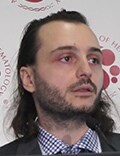High Price for Gene Therapy ― But Cost-Effective in Sickle Cell

NEW ORLEANS — A gene therapy recently made headlines for becoming the most expensive pharmaceutical ever launched — the price tag was $3.5 million for a one-off treatment with etranacogene dezaparvovec (Hemgenix) for hemophilia B.
A gene therapy for sickle cell anemia is in late clinical development and could be on the market soon. It also will likely have a hugely expensive price tag.
However, it has the potential to be a cost-effective therapy for patients with sickle cell disease (SCD) in the United States, say investigators who analyzed the costs using a novel method that takes into account historical heath inequities.
These are potentially curative therapies, but they put financial pressure on publicly and privately funded health insurance.

Dr George Goshua
“When faced with costs of innovative, one-time-administered therapies, budgetary constraints, as we all know too well, can and have driven therapy availability or lack thereof for patients,” said George Goshua, MD, from the Yale School of Medicine in New Haven, Connecticut, speaking here at the American Society of Hematology (ASH) 2022 Annual Meeting.
“We believe that quantitative consideration of health inequities, in addition to the important quality considerations, may be an additional helpful metric in this decision-making context,” he said.
He noted that SCD predominantly affects Black Americans, “who have historically been a very marginalized population when it comes to healthcare.
“Our study shows that, when we compare the costs of gene therapy and existing standard-of-care treatment for SCD using a technique that accounts for historical health disparities, gene therapy could be an equitable therapeutic strategy for all patients with SCD, whether their disease is mild, moderate, or severe,” he said.
Commenting on the study for Medscape Medical News, Bosula Oluwole, MD, from the University of Washington, who studies sickle cell disease but was not involved in this study, said the cost-analysis approach taken by Goshua and colleagues is interesting, but he added: “I think we still have a way to go in trying to fully understand the issue.
“When you look over time at the cost for a patient to get gene therapy vs the standard of care, it might actually be beneficial to have the gene therapy,” she said.
She noted, however, that some patients start gene therapy for SCD at older ages and that it’s important to analyze whether the treatment can still be cost-effective or the best therapeutic option for such patients.
Adding a D to CEA
Goshua and colleagues at Yale and the Harvard T. H. Chan School of Public Health in Boston conducted what they believe is the first study in hematology to use distributional cost-effectiveness analysis (DCEA), which was developed at the University of York, United Kingdom.
A University of York website explains that DCEA “is a general umbrella term for economic evaluation studies that provide information about equity in the distribution of costs and effects as well as efficiency in terms of aggregate costs and effects. DCEA can provide distributional breakdowns of who gains most and who bears the largest burdens (opportunity costs) by equity-relevant social variables (eg socioeconomic status, ethnicity, location) and disease categories (eg severity of illness, rarity, disability).”
The technique can also employ equity weight to evaluate trade-offs between equity and efficiency, the website says.
As Goshua put it, equity weighting is “a way of quantifying how much we prioritize healthcare equity.”
QALYs Considered
Goshua and colleagues included equity weight in an analysis of 10 years of data on annual healthcare costs for patients with SCD who were covered by private insurance and were treated with medications (for example, hydroxyurea), antibiotics, blood transfusion, and hematopoietic stem cell transplants. Sex and the frequency of hospitalizations for acute pain crises were factors in the Markov model they created.
The model assumes that a single course of gene therapy for SCD would cost $2.1 million. The estimate was based on the cost of US Food and Drug Administration–approved gene therapies, and it was assumed that the therapy would result in permanent disease remission for all patients.
In addition, the model assumed that all eligible patients in the US with SCD who are aged 12 years and older would be offered the gene therapy.
In their base-case analysis, gene therapy starting at age 12 would yield 25.5 discounted lifetime quality-adjusted life years (QALYs) at a cost of $2.4 million, compared with 16.0 discounted lifetime QALYs at a cost of $1.1 million for standard care.
Under traditional cost-effectiveness calculations, the upper limit of the incremental cost-effectiveness ratio (ICER) is estimated to be $100,000 per QALY. Under this scenario, the ICER of gene therapy for SCD at $144,000 per QALY would be considered by health economists or insurers to be too steep a price to pay.
However, applying equity weighting to the formula would bring the price of gene therapy into the $1.4 million to $3 million range.
Goshua acknowledged that the study is limited by the assumption that gene therapy would be a one-time cost and that patients would not need to undergo repeat therapy or treatment for relapses.
Stephanie Lee, MD, MPH, from the Fred Hutchinson Cancer Center in Seattle, Washington, and a former ASH president, who moderated a briefing the day before Goshua presented his data, recommended that he and his colleagues use their technique to explore other health inequities, such as in the care of patients with multiple myeloma.
“There’s some evidence that Black patients are not using even the agents we have as some of the other groups, so there may be some distributional inequities there as well,’ she said.
<The study was funded by ASH and the Yale School of Medicine. Goshua, Oluwole, and Lee have disclosed no relevant financial relationships.
American Society of Hematology (ASH) 2022 Annual Meeting: Abstract 581. Presented December 11, 2022.
Neil Osterweil, an award-winning medical journalist, is a long-standing and frequent contributor to Medscape.
For more news, follow Medscape on Facebook, Twitter, Instagram, and YouTube.
Source: Read Full Article